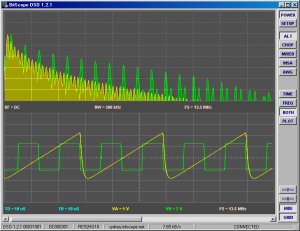
Fig [1] Baseband Spectrum Analyzer (click to enlarge)
(DSO Version 1.2)
A baseband real-time spectrum analyzer is included as part of the core DSO engine.
Its output is available in most virtual instruments that deal with analog waveform data.
The baseband analyzer is integrated with the virtual instruments it serves so there are no additional settings to adjust.
Instead the analyzer adapts automatically to the prevailing timebase, scale, volts/div and screen size to display the optimum resolution magnitude (or phase) spectrum of the waveform.
Fig [1] shows the spectra of the signals connected to the Sydney BitScope as well as the waveforms themselves.
Unlike most swept spectrum analyzers the BitScope spectrum analyzers are fourier transform based and update live at the same high speed refresh rate as the waveform display.
This means it is possible to observe fast moving dynamic features in the spectrum or catch transient spectral events not otherwise visible with a swept spectrum analyzer.
It also means it is possible to zoom and scroll through one-shot waveform captures to view and analyzer the spectrum dynamically at different points in the buffer.
Located at the bottom of the spectrum display is a set of spectrum measurement parameters:
| Id | Name | Description |
| BF | Frequency | The frequency at the left edge of the spectrum display. In baseband this is always "DC". In multiband it's the lowest displayed frequency. |
| BW | Bandwidth | Spectrum bandwidth (aka "Nyquist frequency"). In baseband it is also the highest displayed frequency. |
| FS | Sample Rate | This reports the capture or display sample rate depending on the prevailing data mode; WideBand and Raw Data report the capture rate, Enhanced and Decimated report decimated display rate. |
| FM | Frequency Mark | The value of the mark frequency cursor. |
| FP | Frequency Point | The difference between the point and mark cursor frequencies. |
| MM | Magnitude Mark | The value of the mark level cursor reported in Decibel Relative units. |
| MP | Magnitude Point | The difference between the point and mark levels cursors. |
The normal vertical (ie magnitude) resolution of the spectrum analyzer is 10 dB per grid line and precise dB levels can be measured using the spectrum level cursors.
The spectrum magnitude display is unreferenced; all measurements are relative to the prevailing V/Div value on each channel. If you wish to shift the spectrum up to see low level signals simply increase the vertical scale of the associated channel.
However if you wish to make measurements relative to a standard Decibel scale you can reference the display to show dBu, dBV or dBm values as follows:
| Scale | Reference | Calibration |
| dBu | 0.775V (RMS) | Apply a 1 kHz 0.775V (RMS) voltage to any channel via a 1M Ohm (or greater) probe. Mark the peak of the spectral line for 0 dBu. |
| dBV | 1.0V (RMS) | Apply a 1 kHz 1.0V (RMS) voltage to any channel via a 1M Ohm (or greater) probe. Mark the peak of the spectral line for 0 dBV. |
| dBm | 0.224V (RMS) | Apply a 1 kHz 0.224V (RMS) voltage to channel B with 50 Ohm termination enabled. Mark the peak of the spectral line for 0 dBm. |
The frequency resolution of the spectrum analyzer depends on the bandwidth (ie the prevailing timebase settings) and display sample rate (which depends on display size and display mode).
Choose Dot/Vector or Dot modes to maximize the frequency resolution for a given display size.
If you have a "wide screen" PC, maximize the width of the DSO application to take full advantage of the higher horizontal resolution to further improve the frequency resolution. For example, the display above has been widened to show the first 153 harmonics of a 6.51kHz sawtooth waveform.
The bandwidth is reported via the BW parameter and the graticule has 10 vertical divisions allowing quick frequency measurement to be made in much the same way as time measurements may be made with waveform displays.
More precise measurements of spectral features can be made using frequency cursors.